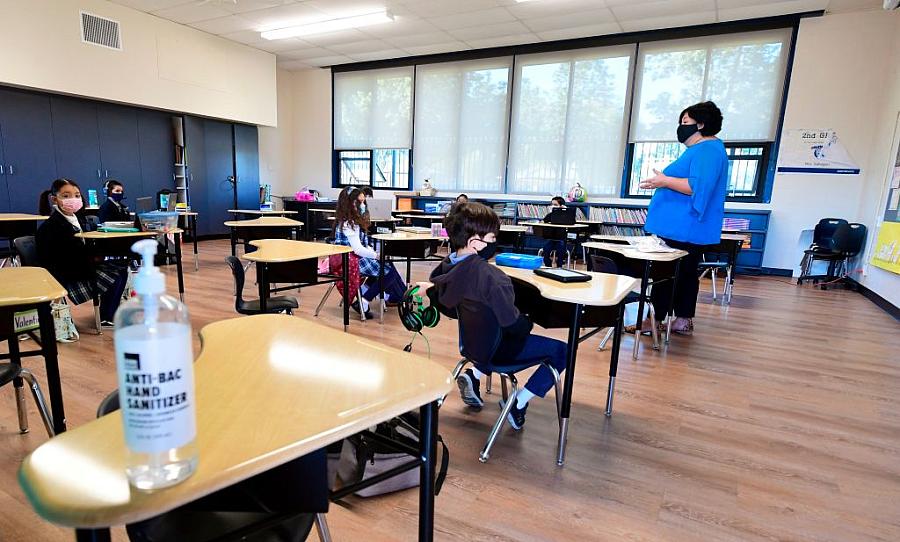Reporters explain why school reopenings remain a huge story in the months to come

(Photo by Frederic J. BROWN / AFP)
Claire Mitzel started covering education for The Roanoke Times on March 10, 2020. Days later, well, you know what happened.
Since then, Mitzel has been writing about all the latest pandemic-related educational developments — from Virginia schools closing, to the challenges of remote and hybrid learning, to the push to return to in-person education.
“It feels like now I’m an old pro at this,” she said.
Mitzel said the key to juggling it all has been staying organized, particularly since she — like many education reporters across the country — covers multiple school districts. She stays abreast of what each is doing, and tracks the factors they’re considering in their decisions to reopen, such as air quality, staffing and the number of outbreaks.
“We've been trying to dive into those and look at — are schools actually meeting these (benchmarks), or are they just saying they are?” she said.
Meanwhile, guidance from state and local health departments and the federal government continues to change. For instance, the Centers for Disease Control and Prevention recently relaxed its social distancing recommendations for students from 6 feet to 3.
“I feel like I'm playing science reporter too,” Mitzel said. She finds herself reading a lot of research on disease transmission.
As coronavirus cases are down from their winter peak and more Americans get the COVID-19 vaccine, schools around the U.S. have been discussing how to safely welcome back students full time. President Joe Biden has vowed that most schools would reopen in his first 100 days in office, and recently signed into law a $1.9 trillion COVID relief package that includes $126 billion for K-12 schools to improve safety measures and address learning loss.
In the months ahead, education reporters — who, like most journalists during the pandemic, have become de facto health reporters — will be busy deciphering how all this affects their local school districts, each with their own set of rules and politics that will dictate how quickly they reopen.
Anita Cicero, deputy director of the Johns Hopkins University Center for Health Security, said we know a lot more about COVID-19 transmission now compared to last summer, when many districts were figuring out their plans for the start of the 2020-21 school year. For example, more emphasis is being placed on the importance of proper ventilation systems, she said. (See this amazing visualization by The New York Times for more on that topic.)
But until there’s herd immunity from the COVID-19 vaccines — and shots for children are still in clinical trials — there aren’t going to be any simple answers, Cicero noted. She said the excitement of the vaccines is also causing people to seek testing less, which presents a dilemma of its own.
“If we want to eliminate the risk of COVID cases and deaths, we'd have to keep schools closed indefinitely,” she said. “If we want to eliminate the significant harm of keeping schools virtual from an education and emotional standpoint, then we need to reopen fully and get everybody back in school.
“But we can't have it both ways. So we need to meet in the middle.”
She envisions that “middle” as strict enforcement of safety measures such as masking, better ventilation, and stronger testing and contract tracing. “Even though it’s not easy, that’s the pathway back to school,” she said.
Jacqueline García, a reporter for La Opinión, a Spanish-language news outlet in Los Angeles, says she’s been focusing on what schools in her coverage area are doing to keep students safe, as well as the “lack of representation of Latino parents in decisions pertaining to their children.”
Since many of those parents remain ineligible for vaccines, they fear their kids can still bring the virus home to them and that it may be too early to open schools.
García said that, when reporting on this issue, she looks for families to interview rather than just relying on school officials.
“It is always interesting to hear the testimonies of those being affected,” she said. “It is very easy to write a press release to praise the work of school districts but it doesn't truly show what people, mainly those in low-income communities, are facing.”
Mitzel, from The Roanoke Times, has been plotting out the topics she plans to cover in the months ahead.
The list includes how schools are going to help the many kids who’ve fallen behind in their education during the pandemic. She said districts in her coverage area intend to provide enhanced, in-person summer school to narrow the COVID learning gap.
She says she’ll also be paying close attention to upcoming school board elections, which appear to be more competitive than in years past. Many citizens, previously uninvolved in politics, have been entering the races because of their anger over their district’s reopening strategies.
She’s also started asking whether schools will offer an all-virtual option in the fall, which could still be critical for kids with preexisting health problems or immunocompromised family members, as we await the availability of childhood vaccines for the coronavirus.
“I’m already thinking ahead to the next school year,” Mitzel said. “I know it seems early.”

